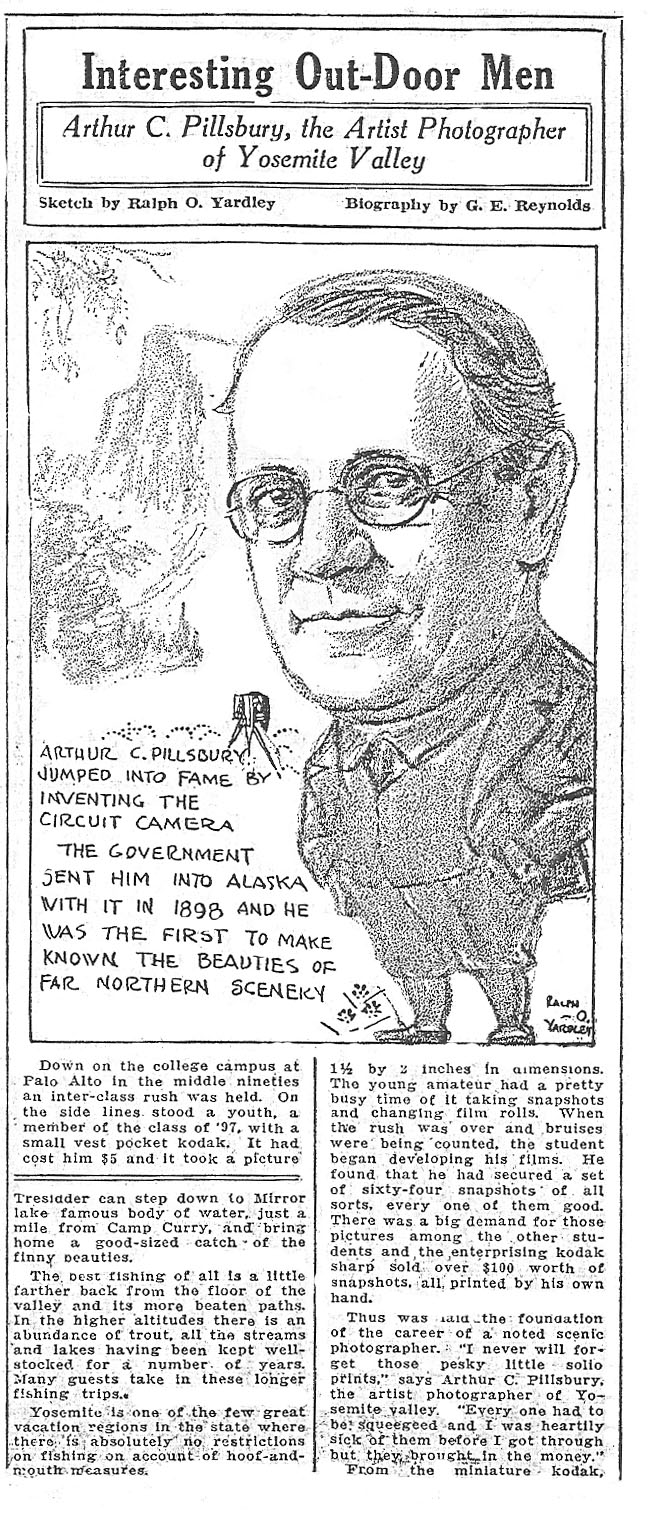We're committed to helping you
Mariposa Gazette - May 24, 1924
This article was published at just the time Arthur C. Pillsbury was building the new Pillsbury Studio in the New Village. The article is three pages long and includes a number of insights into Pillsbury's use of photography to change how people viewed the world of nature.
Down on the college campus at Palo Alto in the middle nineties an inter-class rush was held. On the side lines stood a youth, a member of the class of ’97, with a small vest pocket Kodak. It has cost him $5 and it took a picture 1 ½ by 3 inches in dimensions. The young amateur had a pretty busy time of it taking snapshots and changing film rolls. When the rush was over and bruises were being counted the student began developing his films. He found that he had secured a set of sixty-four snapshots of all sorts, every one of them good. There was a big demand for those pictures among the other students and the enterprising Kodak sharp sold over $100 worth of the snapshots all printed by his own hand.
Photographs Alaskan Scenery
As a result of his success with the panoramic camera, the U. S. census bureau appointed him official government photographer in 1898 and sent him into Alaska to secure a series of views showing the scenery of the far North for government records. Mr. Pillsbury has some interesting experiences in Alaska which were not without real thrills. Securing a birch lark canoe, he started out alone with his cameras from Bennett, at the head of the Yukon, and traveled down stream 2400 miles, camping wherever night overtook him. At times his canoe almost upset as his shot through the rapids but he managed to come through in safety and to bring out a wonderful set of negatives. His reputation was established forthwith.
His San Francisco
Fire Experience
Pillsbury spent two years in Alaska and on coming out of the North went into general photography, first in Seattle and later in San Francisco. For three years prior to the San Francisco fire of 1906, he was the head staff photographer for the San Francisco Examiner. When the great city by the Golden Gate was laid low, he secured the only set of professional pictures taken showing the burning of the city.
Opens Yosemite Studio
Shortly after the conflagration Pillsbury bought out a studio in Yosemite Valley and decided to go in for scenic views exclusively. He has been a national park photographer ever since. His photographic masterpieces of the valley of wonders are known throughout the world.
His moving Pictures
Of Yosemite Flowers
But the greatest achievement of Pillsbury’s career was attained when after five years of study and experiment he perfected a method of taking moving pictures showing the flowers of Yosemite valley and the higher regions of the national park as they bud and burst into bloom. Those how attended Mr. Pillsbury’s lecture at the new Stockton High school auditorium Wednesday evening were given an inkling of his artistic photographic triumph. Mr. Pillsbury generously drove all the way down to Stockton from Yosemite Valley to give the people mediumship of the Stockton Nature Study club and E. C. Lingston. Unfortunately the new high school auditorium was not equipped with a moving picture machine, and the small portable apparatus provided locally for the occasion not only failed to project the pictures on the screen with sufficient brilliancy to make them effective but at times ‘acted up’ and refused to project at all. There was a splendid audience present. Mr. Pillsbury accepted the disappointment with remarkable grace. With the stereopticon he was able to obtain results that were really fine and the audience was kept entertained.
Mrs. Pillsbury’s Sympathetic Aid
Mr. Pillsbury, of course, loves Yosemite and the outdoors. He recently disposed of his studios in Pasadena and San Francisco and henceforth will devote himself exclusively to his studio in Yosemite. He has made a special study of plant life of the park and in this pursuit he has had the sympathetic aid and interest of Mrs. Pillsbury, formerly Miss Sadie Banfield, a botanist of Tacoma, Wash. Much of the credit for his success in his photographic studies of the flowers of Yosemite he attributes to the encouragement given him my Mrs. Pillsbury.
Will Build New Studio
Will photograph Hawaii Park
This autumn Mr. and Mrs. Pillsbury will ship their car to Honolulu and Mr. Pillsbury will spend the winter taking pictures of the wonderful Hawaiian scenery. He will visit the Hawaiian National Park and will from the air shoot Kilauea, the active volcano which has appeared so much in the news of late. Mr. Pillsbury plans to circle the volcano in a government airplane as he trains his movie camera on the crater and grinds the crank.
Mr. Pillsbury is a native of Medford, Mass, but he came to California in 1883 and is just as enthusiastic over California’s scenery as any dyed-in-the wool native son.
Pillsbury Story - Text rekeyed from the original article:


